.
Administrative Region : Peloponnese
Regional unit : Argolida
Nafplio (Modern Greek: Ναύπλιο , Nafplio) is a seaport town in the Peloponnese in Greece that has expanded up the hillsides near the north end of the Argolic Gulf. The town was the first capital of modern Greece, from the start of the Greek Revolution in 1821 until 1834. Nafplio is now the capital of the peripheral unit of Argolis.
Name
Panorama of the city.
View of Bourtzi.
The city was named Nauplia (Ναυπλία) in ancient Greek[1][2][3][4] and Latin.[5] In Ionian Greek, it was also known as Naupliē (Ναυπλιη[1]).
In Byzantine Greek, several variants were used, including Naúplion (Ναύπλιον), Anáplion (Ἀνάπλιον), and Anáplia (Ἀνάπλια).[4] The Turkish name of the town was Mora Yenişehri, after Morea, a medieval name for the Peloponnese, and "yeni şehir," the Turkish for "new city". In Italian, the town was formerly known as Napoli or Napoli di Romania, after the medieval usage of "Romania" to refer to the lands of the Byzantine Empire.
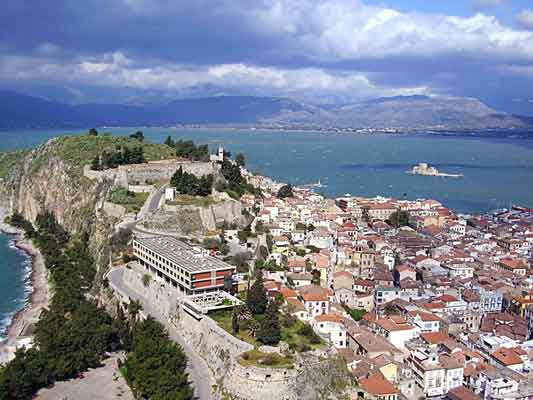
In modern Greek, the town is now called Nafplio (Ναύπλιο[6]), although English continues to employ Nafplion, Navplion, and Nauplia as well.[7]
Geography
Nafplion is situated on the Argolic Gulf in the northeast Peloponnese. Most of the old town is on a peninsula jutting into the gulf; this peninsula forms a naturally protected bay that is enhanced by the addition of man-made moles. Originally almost isolated by marshes, deliberate landfill projects, primarily since the 1970s, have nearly doubled the land area of the city.
Municipality
The municipality Nafplio was formed at the 2011 local government reform by the merger of the following 4 former municipalities, that became municipal units:[8]
Asini
Midea
Nafplio
Nea Tiryntha
|
|
||
|
|
||
History
The area surrounding Nafplion has been inhabited since ancient times though little sign of this remains within the town. The town has been a stronghold at several times in history. It seems to be mentioned on an Egyptian funerary inscription of Amenophis III as 'Nuplija'.[9]
Medieval Era
Further information: Byzantine Greece and Ottoman Greece
Nafplion, or Napoli di Romania, in the mid-16th century.
The Acronauplia has walls dating from pre-classical times. Subsequently, Byzantines, Franks, Venetians, and Turks added to the fortifications. Nafplion was taken in 1212 by the French crusaders of the Principality of Achaea, then in 1388 was sold to the Republic of Venice.[10] During the subsequent 150 years, the lower city was expanded and fortified, and new fortifications added to Acronauplia.[11] The city was surrendered to the Ottomans in 1540, who renamed it Mora Yenişehri and established it as the seat of a sanjak. At that period, Nafplion looked very much like the 16th century image shown below to the right.
The Venetians retook Nafplion in 1685 and strengthened the city by building the castle of Palamidi, which was in fact the last major construction of the Venetian empire overseas. However, only 80 soldiers were assigned to defend the city and it was easily retaken by the Ottomans in 1715. Palamidi is located on a hill north of the old town. During the Greek War of Independence, it played a major role. It was been captured by Staikos Staikopoulos on 31 November 1821.
Greek War of Independence
The castle of Palamidi; was used as a prison cell of Theodoros Kolokotronis.
Ioannis Kapodistrias' murder.
During the Greek War of Independence, Nafplion was a major Ottoman stronghold and was besieged for more than a year. The town finally surrendered because of starvation. After its capture, because of its strong fortifications, it became the seat of the provisional governments of Greece.
Count Ioannis Kapodistrias, first head of state of newly-liberated Greece, set foot on the Greek mainland for the first time in Nafplio on 7 January 1828 and made it the official capital of Greece in 1829. He was subsequently assassinated by members of the Mavromichalis family on the steps of the church of Saint Spyridon in Nafplio on 9 October 1831. After his assassination a period of anarchy followed, until the arrival of King Otto and the establishment of the new Kingdom of Greece. Nafplion remained the capital of the kingdom until 1834, when King Otto decided to move the capital to Athens.
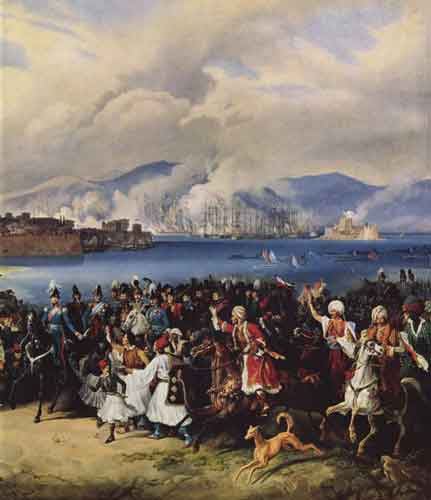
King Otto arrives in Nafplion, Peter von Hess, 1835.
Modern Era
Plateia Syntagmatos (Constitution Square).
A street in Nafplion.
Nafplion Promenade.
Tourism emerged slowly in the 1960s, but not to the same degree as around other areas of Greece; nevertheless, it tends to attract a number of tourists from Germany and the Scandinavian countries in particular. Nafplion enjoys a very sunny and mild climate, even by Greek standards, and as a consequence has become a popular day- or weekend road trip destination for Athenians in wintertime.
Nafplion is a port, with fishing and transport ongoing, although the primary source of local employment currently is tourism, with two beaches on the other side of the peninsula from the main body of the town and a large amount of local accommodation. There are frequent bus services from/to Athens (KTEL).
Education
Square of the Philhellenes.
Since 2003, the University of Peloponnese has incorporated a new faculty, the School of Fine Arts. In 2007, a single department exists; the Department of Theatre,[12] offering four majors:[13]
Theatrical Studies [2]
Acting & Directing
Set design & Costume design
Dance
The building of the National Bank of Greece is probably the only building in the world built in the Mycenaean Revival architectural style.[14]
Population
Year Municipal district Municipality
1981 10,611 -
1991 11,897 14,740
2001 - 16,885
Notable people
The church of Saint Nicholas.
Nicolas "the Greek": One of the 18 survivors of the expedition that completed the first circumnavigation of the world in 1519-1522 (see Victoria (ship)).
Tellos Agras (1880–1907), fighter in the Greek Struggle for Macedonia.
Nina Bawden (born 1925), writer (resident).
Austen Kark (1926–2002) managing director of the BBC World Service (resident).
Nikos Karouzos (poet) (1926–1990), poet.
Vangelis Kazan (1936–2008), actor.
Sotirios Sotiropoulos (1831–1898), lawyer, politician and former Prime Minister of Greece.
Angelos Terzakis (1907–1979), writer.
Charilaos Trikoupis (Greek: Χαρίλαος Τρικούπης) (July 11, 1832 – April 1896), Prime Minister of Greece seven times from 1875 until 1895.
Sister Cities
France Amiens, France
Russia Kronstadt, Russia
United States Niles, Illinois, United States[15]
Germany Ottobrunn, Germany
Georgia (country) Poti, Georgia
United States Ypsilanti, Michigan, United States
See also
History of Greece
Politics of Greece
List of traditional Greek place names
References
^ a b http://www.perseus.tufts.edu/
^ http://www.perseus.tufts.edu/hopper/text?doc=Perseus%3Atext%3A1999.04.0058%3Aentry%3D*naupli%2Fa
^ http://www.archive.org/details/AbrgDuDictionnaireGrecFranais
^ a b http://www.perseus.tufts.edu/
^ http://books.google.com/books?id=v20OAAAAQAAJ&pg=PT934
^ http://argolikivivliothiki.gr/
^ Merriam-Webster's Collegiate Dictionary (1993). Tenth Edition. Merriam-Webster, Springfield, Mass., USA. p. 1495.
^ Kallikratis law Greece Ministry of Interior (Greek)
^ Latacz, Joachim (2004). Troy and Homer: Towards the Solution of an Old Mystery. Oxford University Press. p. 131.
^ Diplomatarium No. 127.
^ Wright, Ch. 1.
^ "http://www.uop.gr/ Faculties and Departments". University of Peloponnese website. www.uop.gr.
^ (Greek) "Study Plan". University of Peloponnese, Department of Theater Studies website.
^ Greece At Its Most Greek , by Phyllis rose, Sept. 10, 2000, New York Times. [1]
^ "Niles Sister Cities". Official website. The Village of Niles. 2010. Retrieved 2010-01-04.
Sources
Bailly, Anatole (1901). Abrégé du dictionnaire grec-français. Hachette, Paris, France. p. 585. ([3])
Entick, John. A Compendious Dictionary of the English and Latin Tongues. New edition carefully revised and augmented throughout by Rev. M.G. Sarjant. London, 1825. ([4])
Ellingham, Mark; Dubin, Marc; Jansz, Natania; and Fisher, John (1995). Greece, the Rough Guide. Rough Guides. ISBN 1-85828-131-8.
Gerola, Giuseppe (1930–31). “Le fortificazioni di Napoli di Romania,” Annuario dell regia scuola archeologicca di Atene e delle missioni italiane in oriente 22-24. pp. 346–410.
Gregory, Timothy E. (1983). Nauplion. Athens.
Karouzos, Semnes (1979). To Nauplio. Athens.
Kolokotrones, Theodoros (1969). Memoirs from the Greek War of Independence, 1821-1833. E. M. Edmunds, trans. Originally printed as Kolokotrones: The Klepht and the Warrior. Sixty Years of Peril and Daring. An Autobiography. London, 1892; reprint, Chicago.
Lamprynides, Michael G. (1898). Ê Nauplia. Athens, reprint 1950.
Liddell, Henry George; and Scott, Robert (1889). An Intermediate Greek-English Lexicon. Oxford. Clarendon Press. ([5])
Liddell, Henry George; and Scott, Robert (1940). A Greek-English Lexicon. Revised and augmented throughout by Sir Henry Stuart Jones, with the assistance of Roderick McKenzie. Oxford. Clarendon Press. ([6])
Luttrell, Anthony (1966). “The Latins of Argos and Nauplia: 1311-1394,” Papers of the British School at Rome. Vol. 34, pp. 34–55.
McCulloch, J. R. (1866). "A Dictionary, Geographical, Statistical, and Historical of the Various Countries, Places, and Principal Natural Objects in the World". New edition carefully revised. Longmans, Green, and Co., London, UK. p. 457. ([7])
Schaefer, Wulf (1961). "Neue Untersuchungen über die Baugeschichte Nauplias im Mittelalter," Jahrbuch des Deutschen Archäologischen Instituts. Vol. 76, pp. 156–214.
Smith, William (Ed.) (1854). Dictionary of Greek and Roman Geography. Walton and Maberly, London, UK. ([8])
Thomas, George Martin (1966). Diplomatarium Veneto-Levantinum. B. Franklin, New York, USA. ([9])
Wright, Diana Gilliland (1999). Bartolomeo Minio: Venetian administration in 15th-Century Nauplion. Doctoral dissertation. The Catholic University of America, Washington DC, USA.
|
Municipalities and communities of the Argolis Prefecture Argos | Asini | Asklipieio | Epidaurus | Ermioni | Koutsopodi | Kranidi | Lerna | Lyrkeia | Midea | Mykines | Nafplion | Nea Kios | Nea Tiryntha |
| Municipal unit Nafplieon |
|---|
| Municipal Community Nafplieon |
| Bourtzi (Μπούρτζι, το (νησίς)) |
| Nafplio (Ναύπλιο, το) |
| Community Aria |
| Aria (Άρια, η) |
| Community Lefkakia |
| Lefkakia (Λευκάκια, τα) |
| Community Pyrgiotika |
| Asprovrysi (Ασπρόβρυση, η) |
| Paliochora (Παληοχώρα, η) |
| Pyrgiotika (Πυργιώτικα, τα) |
| Ancient Greece
Science, Technology , Medicine , Warfare, , Biographies , Life , Cities/Places/Maps , Arts , Literature , Philosophy ,Olympics, Mythology , History , Images Medieval Greece / Byzantine Empire Science, Technology, Arts, , Warfare , Literature, Biographies, Icons, History Modern Greece Cities, Islands, Regions, Fauna/Flora ,Biographies , History , Warfare, Science/Technology, Literature, Music , Arts , Film/Actors , Sport , Fashion --- |
Retrieved from "http://en.wikipedia.org/"
All text is available under the terms of the GNU Free Documentation License


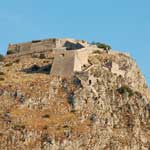
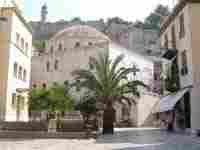
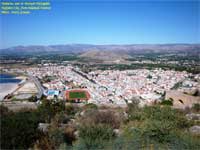
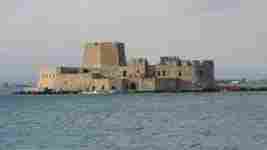
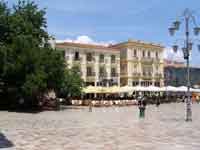
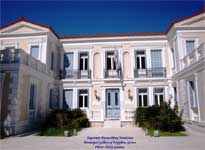 Δημοτική
Δημοτική

